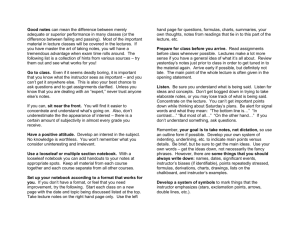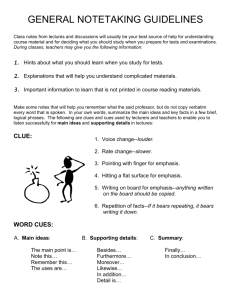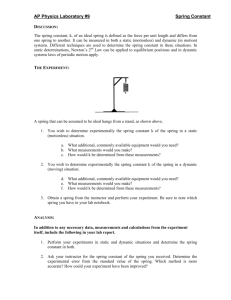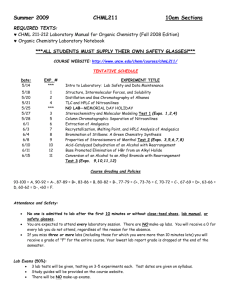Survey of Organic Chemistry Laboratory (CHE 203 Lab)
advertisement
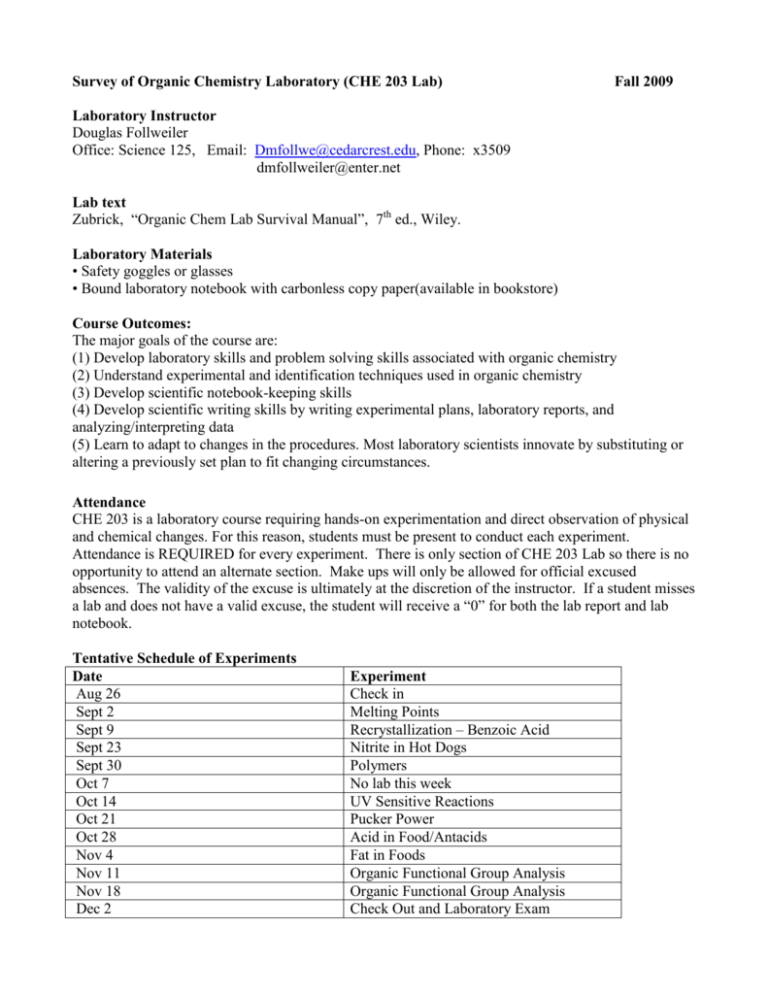
Survey of Organic Chemistry Laboratory (CHE 203 Lab) Fall 2009 Laboratory Instructor Douglas Follweiler Office: Science 125, Email: Dmfollwe@cedarcrest.edu, Phone: x3509 dmfollweiler@enter.net Lab text Zubrick, “Organic Chem Lab Survival Manual”, 7th ed., Wiley. Laboratory Materials • Safety goggles or glasses • Bound laboratory notebook with carbonless copy paper(available in bookstore) Course Outcomes: The major goals of the course are: (1) Develop laboratory skills and problem solving skills associated with organic chemistry (2) Understand experimental and identification techniques used in organic chemistry (3) Develop scientific notebook-keeping skills (4) Develop scientific writing skills by writing experimental plans, laboratory reports, and analyzing/interpreting data (5) Learn to adapt to changes in the procedures. Most laboratory scientists innovate by substituting or altering a previously set plan to fit changing circumstances. Attendance CHE 203 is a laboratory course requiring hands-on experimentation and direct observation of physical and chemical changes. For this reason, students must be present to conduct each experiment. Attendance is REQUIRED for every experiment. There is only section of CHE 203 Lab so there is no opportunity to attend an alternate section. Make ups will only be allowed for official excused absences. The validity of the excuse is ultimately at the discretion of the instructor. If a student misses a lab and does not have a valid excuse, the student will receive a “0” for both the lab report and lab notebook. Tentative Schedule of Experiments Date Aug 26 Sept 2 Sept 9 Sept 23 Sept 30 Oct 7 Oct 14 Oct 21 Oct 28 Nov 4 Nov 11 Nov 18 Dec 2 Experiment Check in Melting Points Recrystallization – Benzoic Acid Nitrite in Hot Dogs Polymers No lab this week UV Sensitive Reactions Pucker Power Acid in Food/Antacids Fat in Foods Organic Functional Group Analysis Organic Functional Group Analysis Check Out and Laboratory Exam Grading There are a total of nine scheduled experiments. Each experiment will require the submission of a report sheet and notebook documentation. There will also be a final lab quiz. The final course grade will be based on the following: 9 Lab Notebook Assignments (25 points each) 225 points 9 Report Sheets (100 points each) 900 points Lab performance: 10% (10 points) of the report sheet will be based on lab performance. Laboratory Final Exam worth 150 points Lab Notebook: All laboratory activities will require documentation in the Lab Notebook. Here are some general guidelines for keeping a good laboratory notebook: a) Leave the first two pages blank for a Table of Contents. b) Write your entries with a blue or black ink ballpoint pen. Your notebook is to be a permanent record of the experiment, so you should never write in it with pencil or erasable ink. c) Date the top of each page as you begin to use it, and number each page consecutively. As you finish a page, sign it at the bottom. d) While you are in lab, keep your notebook open at all times on the bench beside you so that your can record your experimental data and observations immediately. Always write in the bound lab notebook, and never on a paper towel or other scrap of paper. e) As you work through the experiment, record your data and observations chronologically. Don’t leave any gaps to be filled in later. f) Do your best to write neatly, concisely, and above all, legibly. If your entries are messy and can’t be read,your lab instructor may mark them as incorrect. g) If you make a mistake, do not erase it or cover with white-out. Draw a line through it, write the correct entry and initial/date it. Suggested format for the lab notebook: I. Title II. Objective – Write a statement of the overall goal of the experiment. What will you learn, demonstrate or accomplish by performing the experiment? III. Experimental Procedure- If you ever repeat the experiment or you ever need to carry out some related work, your notebook should be a complete guide to do that. Have a table listing all chemicals being used along with physical data such as molecular weight, volume/mass being used, and any special precautions associated with the use of the chemical. If a technique is “new” , be sure to include an adequate description or diagram of it. Any changes that were made must be noted at the relevant point in the procedures. You are writing this section so as to become prepared for the experiment. Before the experiment begins, the instructor may discuss some concepts or procedures. During this presentation you should take notes and add to this section any new information that was not previously recorded. IV. Data/Observations – Faithfully record all data and observations. This section is a record of what you did while you were doing it. What was observed, smelled, heard or felt as the experiment was proceeding? Was heat generated? Was there a color change? Did a precipitate form? Record all numerical data with units. The format of this section may be different depending on the type of experiment. V. Results/Calculations – This is a presentation of how you processed your data and/or interpreted your observations. Clearly label any calculations and show all the work. Present the formula, then enter the experimental data with appropriate units and finally express the result with the appropriate number of significant figures. If a calculation is performed repeatedly, show just one sample calculation and then list the results of the repeated calculations. Any graphs generated would be included in this section. This is also where you would interpret your observations and provide a clear explanation of what was observed while the experiment was taking place. VI. Conclusion – Does the experiment work as planned – if not, why not? Discuss sources of error. Suggest improvements to the experiment. If identifying an unknown, explain your reasoning. Report Sheets Each experiment will require submission of a Laboratory Report Sheet. These are to be turned in at the next meeting of your laboratory class, and they will serve as your formal “Lab Reports.” Your Lab Notebook is a record-keeping book, but its primary purpose is to serve as a learning tool for you. The notebook is where you’ll record your work as you: a) prepare in advance for each experiment, b) make measurements and observations during the experiment, and c) process your data by calculating results after the experiment is complete. Although you want to keep it as neat and legible as possible, the lab notebook is where you can feel free to make mistakes and then correct them. For example, you might discover an error after making or recording a measurement, and have to repeat the measurement a second time. Or you may set up a calculation incorrectly, and then work the problem a second time after getting some direction from your lab instructor. The notebook is the right place to record those learnings. In contrast, the Report Sheets should be completed only after the experiment is done, and after all data,observations, calculations, and results have been worked out and recorded in the lab notebook. The Report Sheet serves as a final neat and clean presentation of your finished work. It must be completed in ink and submitted to your instructor at the start of the next laboratory meeting along with the carbon copies of all relevant pages from your laboratory notebook. 10 points of the report sheet will be based on lab performance. Lab Performance Assessment During each experiment, the instructor will objectively assess each student’s performance in the lab, and award up to ten points for appropriate laboratory behavior and technique. These points are earned by: demonstrating familiarity with the experimental procedure, demonstrating proper experimental technique, properly using the lab notebook to record data/observations, keeping personal lab bench and communal areas clean, properly (and carefully) disposing of waste, interacting appropriately with fellow students and instructors, and adhering to safety regulations. Students who remove their safety glasses during an experiment and must be reminded by the teaching assistant to replace them will immediately lose five points from the lab performance point total awarded for that experiment. Students will work in pairs on each experiment. If a lab section has an odd number of students, one work group may contain three students. No group may have more than three students working together at one time. Laboratory Safety Nothing is more important than the personal safety of the occupants of the laboratory. For this reason, any student who deliberately or carelessly disregards a written or oral safety instruction will be immediately expelled from the laboratory and will receive a grade of zero for the experiment. A student who is expelled twice from the laboratory for safety violations will automatically receive a failing grade in the course. A summary of Chemistry Department Safety rules is attached to the syllabus. Honor Philosophy The Cedar Crest College Honor Philosophy states that students should uphold community standards for academic and social behavior in order to preserve a learning environment dedicated to personal and academic excellence. Upholding community standards is a matter of personal integrity and honor. Individuals who accept the honor or membership in the Cedar Crest College community of scholars pledge to accept responsibility for their actions in all academic and social situations and for the effect their actions may have on other members of the College community Community Standards for Academic Conduct: Academic integrity and ethics remain steadfast, withstanding technological change. Cedar Crest College academic standards therefore apply to all academic work, including, but not limited to, handwritten or computer-generated documents, video or audio recordings, and telecommunications. As a student at Cedar Crest College, each student shall: • Only submit work which is his/her own. • Adhere to the rules of acknowledging outside sources, as defined by the instructor, never plagiarizing or misrepresenting intellectual property. • Neither seek nor receive aid from another student, converse with one another when inappropriate, nor use materials not authorized by the instructor. • Follow the instructions of the professor in any academic situation or environment, including taking of examinations, laboratory procedures, the preparation of papers, properly and respectfully using College facilities and resources, including library and computing resources to ensure that these resources may be effectively shared by all members of the College community. • Abide by the Cedar Crest Computer Use Policy. • If a student perceives a violation of the Academic Standards, he/she will go to their instructor. • If you are unable to resolve the problem with the instructor, you should go to the chair of the department. If you need further assistance after consultation with the instructor and the chair, you should see the Provost. Although students are conducting each experiment in groups of two or three, each student’s Lab Notebook Assignment and Report Sheet must be completed on an individual basis. Students who submit work that is clearly the same as another student’s work are in violation of the University’s Policy on Academic Honesty. Academic dishonesty is a serious offense and a violation of the Cedar Crest Honor Code philospophy. The response to academic dishonesty rests with the instructor. Penalties for academic dishonesty can range from a request to redo an assignment, the assignment of an “F” for the assignment/exam, the assignment of a “F” for the course, to suspension or expulsion. The instructor is entitled to take into account the students degree of academic experience and any prior instances of academic dishonesty in the student’s time at the college, in determining the penalty for the offense. Classroom Protocol Appropriate classroom behavior is defined and guided by complete protection for the rights of all students and faculty to a courteous, respectful classroom environment. That environment is free from distractions such as late arrivals, early departures, inappropriate conversations and any other behaviors that might disrupt instruction and/or compromise students’ access to the Cedar Crest College education. The instructor may request that a disruptive student leave class. Repeated disruptions can lead to class expulsion. Disabilities Students with documented disabilities who may need academic accommodations should discuss these needs with their professor during the first two weeks of class. Students with disabilities who wish to request accommodations should contact the Advising Center. Laboratory Safety The following safety precautions must be observed in the laboratory. After you have read them, complete the last page of this handout and give it to the laboratory instructor. No student will be allowed to work in the lab without the signed attached sheet acknowledging understanding of safety rules. 1. Some form of eye protection is required at all times. Safety glasses, with side shields are best, but normal eyeglasses are permitted. Contact lenses are not to be worn in the laboratory. Serious damage to the eye can result. If you must wear contact lenses, then goggles must be worn as well. 2. Avoid wearing open-toed (or open-heeled) shoes and canvas shoes. Wear something that will protect the foot. 3. Wear old clothes, preferably nonsynthetic, that fit. Don’t wear frilled or flared shirts. Lab coats or aprons are suggested. 4. Secure long hair and remove necklaces or scarves when working in the lab. 5. No smoking, food or drink is permitted in the lab at any time. 6. Note the locations of eye washes, fire extinguishers, showers, fire blankets, and exits. 7. Rinse any chemicals from eyes or off body immediately using eye washes , sinks, or showers depending on the spill. 8.. Always pay attention to the instructor’s advice regarding the potential hazards of any particular experiment. 9. Always come into the lab knowing what you will be doing. Read the procedure beforehand. Complete sections I and II in your lab notebook before the start of the lab. Take note of any special safety hazards associated with a specific experiment. 9. Never work in the laboratory alone. 10. Unauthorized experiments are prohibited. 11. Notify the instructor at once in case of accident or emergency. 12. Always wash hands and arms thoroughly before leaving lab. Get in the habit of periodically washing hands during the lab. 13. Be aware of the composition of all reagents being handled and handle appropriately. Consult MSDS (Material Safety Data Sheet) if necessary. A sample of an MSDS is attached to this handout. 14. Always consult the instructor if you have any doubts about starting or continuing a procedure. 15. Never taste or directly smell any chemicals. 16. Never pipet by mouth. 17. Never lean directly over a chemical reaction and do not point a test tube, sep funnel or reaction flask at a neighbor. 18. Never add water to concentrated acid. A violent reaction will occur. With caution, add acid to water. 19. Read the label on a reagent bottle twice before removing any chemicals. This helps to prevent accidents and unexplained results. In addition, chemicals located in the fume hoods are usually noxious otr toxic. Remove them only with instructor permission. 20. Dispose of hazardous materials properly. Waste containers will be provided in the hood for these chemicals. Do not place other chemicals in these waste containers. Broken glassware shopuld be disposed of in the container so designated. Do not put in waste paper basket. 21. Always check beakers and flasks for cracks before applying any heat. Otherwise, the vessel may shatter and the hot liquid can cause serious injury. Replace cracked or broken glassware immediately. 22. Always clean your lab area before you leave. 23. All material should be properly labeled with contents, your name, date, class ,and experiment. Labeling is critical to avoid improper use or disposal of material. Containers without labels are a hazard. 24. Be familiar with the NFPA hazard labeling system. These labels appear on reagent bottles. Numbers in the zone range from zero to four with four being the most hazardous. The system is designed to instantly warn workers of hazard levels. On the following page, you will find a detailed description of the NFPA Hazard label. 25. Pay attention to the experiment. If you need to leave the lab, notify the instructor and be sure that your experiment is being watched by a partner/neighbor or instructor.

